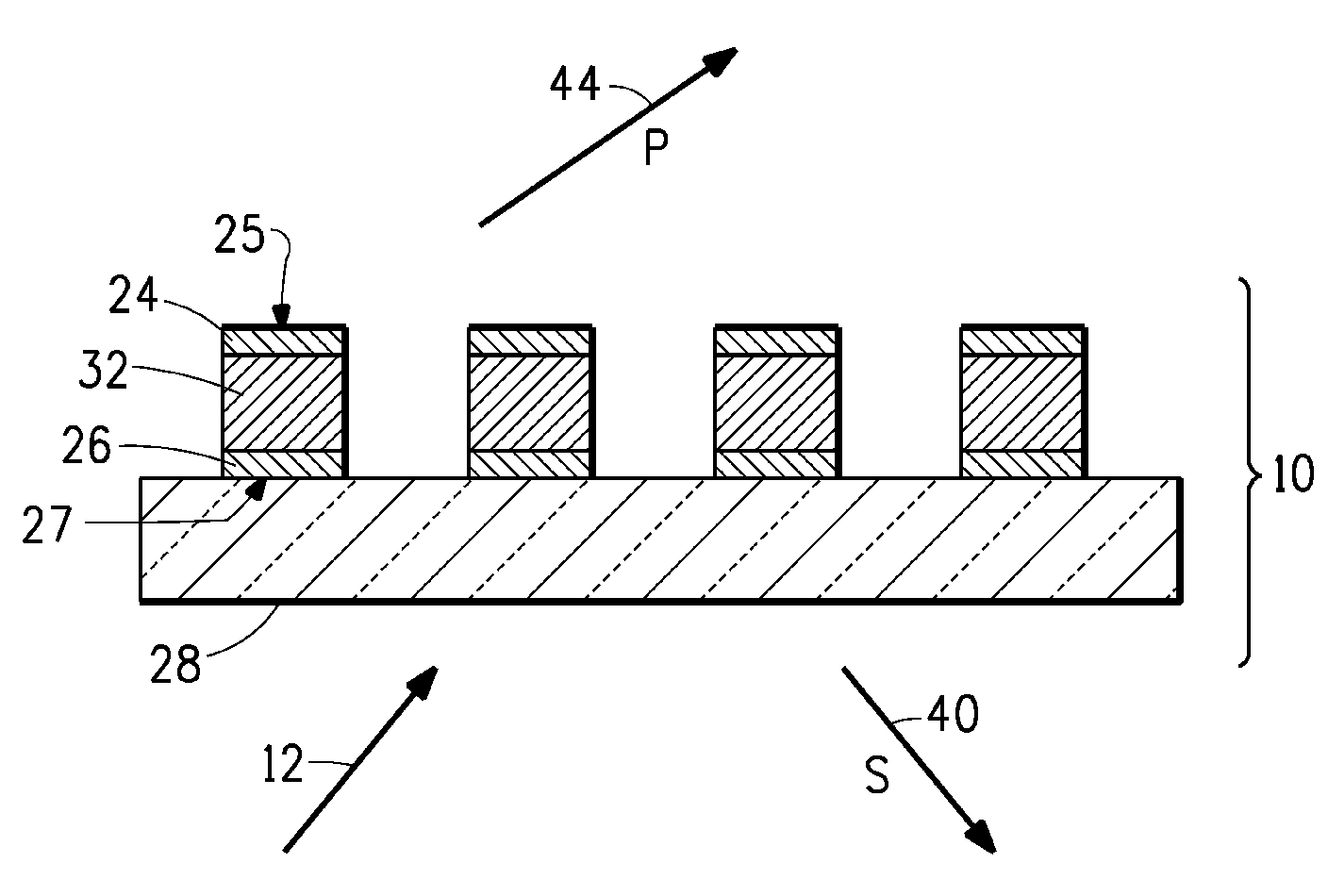Wire-grid polarizers, methods of fabrication thereof and their use in transmissive displays
a technology of transmissive display and wire grid, which is applied in the direction of polarising elements, instruments, optics, etc., can solve the problem that plain glass does not transmit 100% of incident light, and achieve the effect of imparting high contrast and brightness characteristics to the display
- Summary
- Abstract
- Description
- Claims
- Application Information
AI Technical Summary
Benefits of technology
Problems solved by technology
Method used
Image
Examples
example 1
[0058]This sample was made by spin-coating a mixture of one-third Microposit® Type P Thinner (Rohm and Haas Electronic Materials, LLC, Marlborough, Mass.) and two-third Microposit® S1805 Positive Photoresist (Rohm and Haas Electronic Materials, LLC, Marlborough, Mass.) onto a 152 mm×100 mm×2 mm thick piece of soda-lime glass for 30 seconds at 3500 RPM. The plate was then dried on a hotplate at 100° C. for 15 minutes. The plate was placed into a Lloyd's mirror set-up at 56° incident. The plate was exposed using the 364.8 nm line from a Coherent Argon Sabre Laser (Coherent, Inc., Santa Clara, Calif.) for 30 seconds to form an interference sinusoidal interference pattern with a period of 220 nm peak to peak. The sample was then developed in a mixture of 4 parts deionized water and one part Microposit® 351 Developer (Rohm and Haas Electronic Materials, LLC, Marlborough, Mass.) for 20 seconds, rinsed with deionized water for 10 seconds, and dried with forced air. The developed plate was ...
example 2
[0059]This sample was made by spin-coating a mixture of one-third Microposit® Type P Thinner (Rohm and Haas Electronic Materials, LLC, Marlborough, Mass.) and two-third Microposit® S1805 Positive Photoresist (Rohm and Haas Electronic Materials, LLC, Marlborough, Mass.) onto a piece of 200 gauge Melinex® 455 polyethylene terephthalate (PET, DuPont Teijin Films, Hopewell, Va.) taped on all four sides down to a 152 mm×100 mm×2 mm thick piece of soda-lime glass for 30 seconds at 3500 RPM. The plate was then dried on a hotplate at 100° C. for 15 minutes. The plate was placed into a Lloyd's mirror set-up at 56° incident. The plate was exposed using the 364.8 nm line from a Coherent Argon Sabre Laser (Coherent, Inc., Santa Clara, Calif.) for 30 seconds to form an interference sinusoidal interference pattern with a period of 220 nm peak to peak. The sample was then developed in a mixture of 4 parts deionized water and one part Microposit® 351 Developer (Rohm and Haas Electronic Materials, L...
PUM
 Login to View More
Login to View More Abstract
Description
Claims
Application Information
 Login to View More
Login to View More - R&D
- Intellectual Property
- Life Sciences
- Materials
- Tech Scout
- Unparalleled Data Quality
- Higher Quality Content
- 60% Fewer Hallucinations
Browse by: Latest US Patents, China's latest patents, Technical Efficacy Thesaurus, Application Domain, Technology Topic, Popular Technical Reports.
© 2025 PatSnap. All rights reserved.Legal|Privacy policy|Modern Slavery Act Transparency Statement|Sitemap|About US| Contact US: help@patsnap.com



